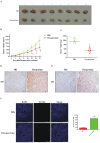Flavopereirine Suppresses the Growth of Colorectal Cancer Cells through P53 Signaling Dependence
- PMID: 31336690
- PMCID: PMC6678721
- DOI: 10.3390/cancers11071034
Flavopereirine Suppresses the Growth of Colorectal Cancer Cells through P53 Signaling Dependence
Abstract
Colorectal cancer (CRC) is a significant cause of morbidity and mortality worldwide. The outcome of CRC patients remains poor. Thus, a new strategy for CRC treatment is urgently needed. Flavopereirine is a β-carboline alkaloid extracted from Geissospermum vellosii, which can reduce the viability of various cancer cells through an unknown mode of action. The aim of the present study was to investigate the functional mechanism and therapeutic potential of flavopereirine on CRC cells in vitro and in vivo. Our data showed that flavopereirine significantly lowered cellular viability, caused intrinsic and extrinsic apoptosis, and induced G2/M-phase cell cycle arrest in CRC cells. Flavopereirine downregulated Janus kinases-signal transducers and activators of transcription (JAKs-STATs) and cellular myelocytomatosis (c-Myc) signaling in CRC cells. In contrast, the enforced expressions of constitutive active STAT3 and c-Myc could not restore flavopereirine-induced viability reduction. Moreover, flavopereirine enhanced P53 expression and phosphorylation in CRC cells. CRC cells with P53 knockout or loss-of-function mutation significantly diminished flavopereirine-mediated viability reduction, indicating that P53 activity plays a major role in flavopereirine-mediated CRC cell growth suppression. Flavopereirine also significantly repressed CRC cell xenograft growth in vivo by upregulating P53 and P21 and inducing apoptosis. In conclusion, flavopereirine-mediated growth suppression in CRC cells depended on the P53-P21, but not the JAKs-STATs-c-Myc signaling pathway. The present study suggests that flavopereirine may be efficacious in the clinical treatment of CRC harboring functional P53 signaling.
Keywords: Flavopereirine; P53; colorectal cancer.
Conflict of interest statement
The authors declare no conflicts of interest.
Figures






Similar articles
-
Flavopereirine exerts anti-cancer activities in various human thyroid cancer cells.Am J Cancer Res. 2024 Jul 15;14(7):3317-3334. doi: 10.62347/MINX1330. eCollection 2024. Am J Cancer Res. 2024. PMID: 39113866 Free PMC article.
-
Flavopereirine-An Alkaloid Derived from Geissospermum vellosii-Presents Leishmanicidal Activity In Vitro.Molecules. 2019 Feb 21;24(4):785. doi: 10.3390/molecules24040785. Molecules. 2019. PMID: 30795632 Free PMC article.
-
Flavopereirine induces cell cycle arrest and apoptosis via the AKT/p38 MAPK/ERK1/2 signaling pathway in human breast cancer cells.Eur J Pharmacol. 2019 Nov 15;863:172658. doi: 10.1016/j.ejphar.2019.172658. Epub 2019 Sep 10. Eur J Pharmacol. 2019. PMID: 31518562
-
Blockage of Glyoxalase I Inhibits Colorectal Tumorigenesis and Tumor Growth via Upregulation of STAT1, p53, and Bax and Downregulation of c-Myc and Bcl-2.Int J Mol Sci. 2017 Mar 9;18(3):570. doi: 10.3390/ijms18030570. Int J Mol Sci. 2017. PMID: 28282916 Free PMC article.
-
P53 mutations in colorectal cancer - molecular pathogenesis and pharmacological reactivation.World J Gastroenterol. 2015 Jan 7;21(1):84-93. doi: 10.3748/wjg.v21.i1.84. World J Gastroenterol. 2015. PMID: 25574081 Free PMC article. Review.
Cited by
-
Ethyl β-Carboline-3-Carboxylate Increases Cervical Cancer Cell Apoptosis Through ROS-p38 MAPK Signaling Pathway.In Vivo. 2022 May-Jun;36(3):1178-1187. doi: 10.21873/invivo.12817. In Vivo. 2022. PMID: 35478127 Free PMC article.
-
The cancer stemness inhibitor napabucasin suppresses small cell lung cancer growth through SOX2 expression.Am J Cancer Res. 2022 Oct 15;12(10):4637-4651. eCollection 2022. Am J Cancer Res. 2022. PMID: 36381330 Free PMC article.
-
Flavopereirine Suppresses the Progression of Human Oral Cancer by Inhibiting the JAK-STAT Signaling Pathway via Targeting LASP1.Drug Des Devel Ther. 2021 Apr 22;15:1705-1716. doi: 10.2147/DDDT.S284213. eCollection 2021. Drug Des Devel Ther. 2021. PMID: 33935493 Free PMC article.
-
Flavopereirine Inhibits Autophagy via the AKT/p38 MAPK Signaling Pathway in MDA-MB-231 Cells.Int J Mol Sci. 2020 Jul 28;21(15):5362. doi: 10.3390/ijms21155362. Int J Mol Sci. 2020. PMID: 32731544 Free PMC article.
-
Flavopereirine exerts anti-cancer activities in various human thyroid cancer cells.Am J Cancer Res. 2024 Jul 15;14(7):3317-3334. doi: 10.62347/MINX1330. eCollection 2024. Am J Cancer Res. 2024. PMID: 39113866 Free PMC article.
References
-
- Karapetis C.S., Khambata-Ford S., Jonker D.J., O’Callaghan C.J., Tu D., Tebbutt N.C., Simes R.J., Chalchal H., Shapiro J.D., Robitaille S., et al. K-ras mutations and benefit from cetuximab in advanced colorectal cancer. N. Engl. J. Med. 2008;359:1757–1765. doi: 10.1056/NEJMoa0804385. - DOI - PubMed
Grants and funding
LinkOut - more resources
Full Text Sources
Other Literature Sources
Molecular Biology Databases
Research Materials
Miscellaneous

